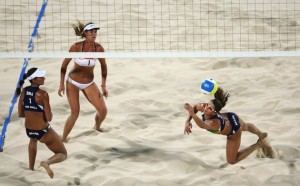So much is happening in the world of sports with the lead-up to the Summer Olympics-- and female athletes have been stealing the spotlight, especially in track (so much has been written on the 100m controversy, but I have to endorse this Sports Illustrated article by Tim Layden as the absolute best I have read on the topic). It's only right that women sports stars are getting so much attention as we celebrate the 40th anniversary of the passage of Title IX. And it's not just that they generate their own headlines in the sports pages these days that matters. What's most important is that thanks to Title IX women achieve more in the classroom and in the boardroom (I've written about Betsey Stevenson's study before here, which includes a link to her interesting paper).
These three athletes who have recently created headlines are a reminder that today women of any age and size can achieve in any sport.
1) Swimming legend Janet Evans is 40 and a mom of two. She also just competed in the Olympic Trials in distance swimming. I know she may not feel like it all the time, but it seems like she has it all.
2) Holley Mangold (in her second appearance in the Shrinking and Pinking series) was just profiled in The New York Times Magazine. Yes, she's 350 pounds. Yes, she wears make-up. Yes, she's NFL star Nick's sister. No, she doesn't want to be skinny. No, she doesn't make a lot of money. No, she probably won't medal in London (US weightlifting is described as the equivalent of the US' Jamaican bobsled team). I'll still be rooting for her and hoping she rocks some hair bows and nail polish, flaunting her awesome skill and femininity.
3) Nineteen-year-old Maggie Parker participates in a sport that isn't even in the Olympics. She's a bull rider. And earlier this month she became the first woman to ever win prize money on the professional bull-riding circuit. It was only $460 but you have to start somewhere.
I doubt Parker'll be doing this when she's 40, like Evans, and she's surely about a third the size of Mangold, but all three women prove that in a post-Title IX world female athletes come in variety of wonderful packages.


